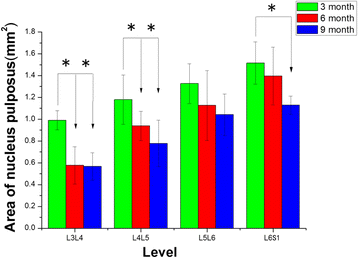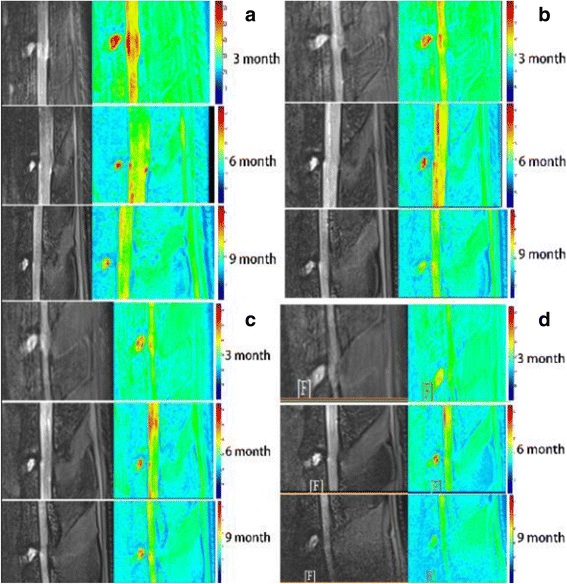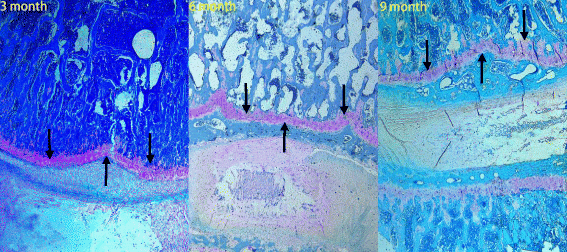Non-invasive quantification of age-related changes in the vertebral endplate in rats using in vivo DCE-MRI
- PMID: 29121960
- PMCID: PMC5680764
- DOI: 10.1186/s13018-017-0669-x
Non-invasive quantification of age-related changes in the vertebral endplate in rats using in vivo DCE-MRI
Abstract
Background: Small animal models that can mimic degenerative disc disease (DDD) are commonly used to examine DDD progression. However, assessments such as histological studies and macroscopic measurements do not allow for longitudinal studies because they can only be completed after the animal is sacrificed. Dynamic contrast-enhanced MRI (DCE-MRI) may provide a reliable, non-invasive in vivo method for detecting the progression.
Methods: The present study investigated the progression of changes in lumbar discs and the effect of endplate conditions on diffusion into the lumbar discs of aging sand rats after intravenous administration of gadolinium-containing contrast medium through the tail vein. Contrast enhancement was measured in the lumbar intervertebral discs on each image. The results were compared with those from conventional histological characterizations.
Results: T2-weighted images revealed that with aging, the shape of L3-L4, L4-L5, L5-L6, and L6-S1 nucleus pulposus (NP) became irregular, while the mean areas, signal intensities, and T2 values of the NP were significantly decreased. Each of the observed disc changes demonstrated a progressive increase in phase during 2-min scout scans. Post-contrast MRI showed impaired endplate nutritional diffusion to the disc with aging, enhancement was significantly greater in young animals than in old animals. Endplate calcification or sclerosis was histologically confirmed; histologic score was correlated with the age. We found the histological score of the endplate negatively corresponded to the DCE-MRI results.
Conclusions: DCE-MRI studies offer a non-invasive in vivo method for investigating the progress of diffusion into the discs and the functional conditions of the endplate. We conclude that quantitative DCE-MRI can identify the severity of disc degeneration and efficiently reflect the progression of vertebral endplate changes in the aging sand rat lumbar spine via the NP contrast enhancement patterns.
Keywords: Degenerative disc disease; Dynamic contrast-enhanced magnetic resonance imaging; Intervertebral disc endplate; Lumbar spine.
Conflict of interest statement
Ethics approval
All animal experiments were approved by the Animal Ethical Committee and Neurosurgical Institute of Beijing, The Capital Medical University.
Consent for publication
Not applicable.
Competing interests
The authors declare that they have no competing interests.
Publisher’s Note
Springer Nature remains neutral with regard to jurisdictional claims in published maps and institutional affiliations.
Figures








Similar articles
-
Vertebral endplate and disc changes in the aging sand rat lumbar spine: cross-sectional analyses of a large male and female population.Spine (Phila Pa 1976). 2007 Nov 1;32(23):2529-36. doi: 10.1097/BRS.0b013e318158cd69. Spine (Phila Pa 1976). 2007. PMID: 17978650
-
Pharmacological enhancement of disc diffusion and differentiation of healthy, ageing and degenerated discs : Results from in-vivo serial post-contrast MRI studies in 365 human lumbar discs.Eur Spine J. 2008 May;17(5):626-43. doi: 10.1007/s00586-008-0645-6. Epub 2008 Mar 21. Eur Spine J. 2008. PMID: 18357472 Free PMC article.
-
Dynamic adaptation of vertebral endplate and trabecular bone following annular injury in a rat model of degenerative disc disease.Spine J. 2018 Nov;18(11):2091-2101. doi: 10.1016/j.spinee.2018.05.045. Epub 2018 Jun 8. Spine J. 2018. PMID: 29886163
-
Diagnostic Role of Magnetic Resonance Imaging in Low Back Pain Caused by Vertebral Endplate Degeneration.J Magn Reson Imaging. 2022 Mar;55(3):755-771. doi: 10.1002/jmri.27858. Epub 2021 Jul 26. J Magn Reson Imaging. 2022. PMID: 34309129 Review.
-
MR imaging of degenerative disc disease.Eur J Radiol. 2015 Sep;84(9):1768-76. doi: 10.1016/j.ejrad.2015.04.002. Epub 2015 Apr 18. Eur J Radiol. 2015. PMID: 26094867 Review.
Cited by
-
Glucose deprivation-induced disulfidptosis in human nucleus pulposus cells: a novel pathological mechanism of intervertebral disc degeneration.Biol Direct. 2024 Sep 12;19(1):81. doi: 10.1186/s13062-024-00528-4. Biol Direct. 2024. PMID: 39267140 Free PMC article.
-
Species variation in the cartilaginous endplate of the lumbar intervertebral disc.JOR Spine. 2022 Aug 25;5(3):e1218. doi: 10.1002/jsp2.1218. eCollection 2022 Sep. JOR Spine. 2022. PMID: 36203863 Free PMC article.
-
Age-dependent microstructural changes of the intervertebral disc: a validation of proteoglycan-sensitive spectral CT.Eur Radiol. 2021 Dec;31(12):9390-9398. doi: 10.1007/s00330-021-08028-z. Epub 2021 May 15. Eur Radiol. 2021. PMID: 33993329 Free PMC article.
-
Large animals in neurointerventional research: A systematic review on models, techniques and their application in endovascular procedures for stroke, aneurysms and vascular malformations.J Cereb Blood Flow Metab. 2019 Mar;39(3):375-394. doi: 10.1177/0271678X19827446. Epub 2019 Feb 7. J Cereb Blood Flow Metab. 2019. PMID: 30732549 Free PMC article.
-
Clinical outcomes and surgical strategy for spine tuberculosis: a systematic review and meta-analysis.Spine Deform. 2024 Mar;12(2):271-291. doi: 10.1007/s43390-023-00785-9. Epub 2023 Nov 17. Spine Deform. 2024. PMID: 37975989 Free PMC article.
References
MeSH terms
Substances
Grants and funding
LinkOut - more resources
Full Text Sources
Other Literature Sources
Medical
Research Materials
Miscellaneous

